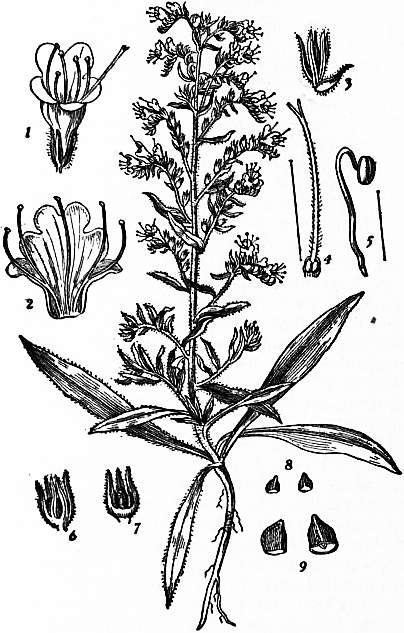1911 Encyclopædia Britannica/Boraginaceae
BORAGINACEAE, an order of plants belonging to the sympetalous section of dicotyledons, and a member of the series Tubiflorae. It is represented in Britain by bugloss (Echium) (fig. 1), comfrey (Symphytum), Myosotis, hounds-tongue (Cynoglossum) (fig. 2), and other genera, while borage (Borago officinalis) (fig. 3) occurs as a garden escape in waste ground. The plants are rough-haired annual or perennial herbs, more rarely shrubby or arborescent, as in Cordia and Ehretia, which are tropical or sub-tropical. The leaves, which are generally alternate, are usually entire and narrow: the radical leaves in some genera, as Pulmonaria (lungwort) and Cynoglossum, differ in form from the stem-leaves, being generally broader and sometimes heart-shaped. A characteristic feature is the one-sided (dorsiventral) inflorescence, well illustrated in forget-me-not and other species of Myosotis; the cyme is at first closely coiled, becoming uncoiled as the flowers open. At the same time there is often a change in colour in the flowers, which are red in bud, becoming blue as they expand, as in Myosotis, Echium, Symphytum and others. The flowers are generally regular; the form of the corolla varies widely. Thus in borage it is rotate, tubular in comfrey, funnel-shaped in hounds-tongue, and salver-shaped in alkanet (Anchusa); the throat is often closed by scale-like outgrowths from the corolla, forming the so-called corona. A departure from the usual regular corolla occurs in Echium and a few allied genera, where it is oblique; in Lycopsis it is also bent.
| Fig. 1.—Viper’s Bugloss (Echium vulgare), about 14 nat. size. | |
1. Single flower, about nat. size. |
6. Calyx surrounding nutlets. |
The five stamens alternate in position with the lobes of the
corolla. The ovary, of two carpels, is seated on a ring-like disk
which secretes honey.

Fig.2.—(1) Inflorescence of
Forget-me-not; (2) ripe fruits.
Each carpel becomes divided by a
median constriction in four portions, each containing one
ovule; the style springs from the centre of the group of four
divisions.
The flowers show well-marked adaptation to insect-visits.
Their colour and tendency to arrangement on one surface, with
the presence of honey, serve to
attract insects. The scales around
the throat of the corolla protect
the pollen and honey from wet or
undesirable visitors, and by their
difference in colour from the corolla-lobes,
as in the yellow eye of
forget-me-not, may serve to indicate
the position of the honey. In most
genera the fruit consists of one-seeded
nutlets, generally four, but
one or more may be undeveloped.
The shape of the nutlet and the
character of its coat are very varied.
Thus in Lithospermum the nutlets
are hard like a stone, in Myosotis
usually polished, in Cynoglossum
covered with bristles, &c.
The order is widely spread in temperate and tropical regions, and contains 85 genera with about 1200 species. Its chief centre is the Mediterranean region, whence it extends over central Europe and Asia, becoming less frequent northwards. A smaller centre occurs on the Pacific side of North America. The order is less developed in the south temperate zone.
Fig. 3.—(1) Flower of Borage; (2) same in vertical section enlarged; (3) horizontal plan of flower; (4) flower of Comfrey after removal of corolla, showing unripe fruit.
The order is of little economic value. Several genera, such as borage and Pulmonaria, were formerly used in medicine, and the roots yield purple or brown dyes, as in Alkanna tinctoria (alkanet). Heliotrope or cherry-pie (Heliotropium peruvianum) is a well-known garden plant.

